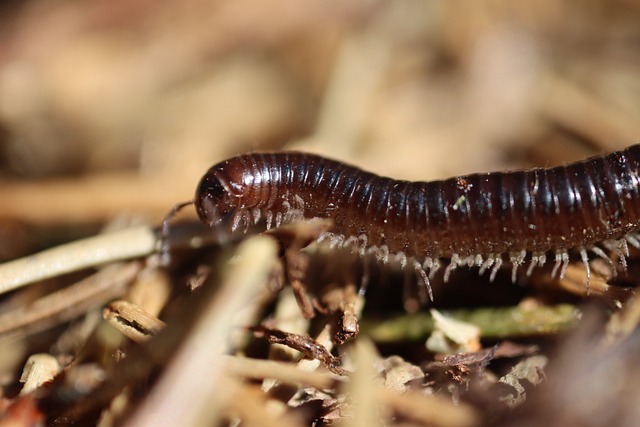Centipedes, nocturnal creatures preferring humid, secluded habitats like cracks and dark corners (basements, crawl spaces, bathrooms), can be controlled through humane, non-toxic methods. These include sealing entry points, reducing moisture levels, using baits or traps, plant-based repellents (citronella, lavender, mint oils), growing lemongrass, marigolds, basil, maintaining a clean, dry environment, and essential oils (peppermint, eucalyptus, tea tree) for insecticidal properties. Natural predators like spiders can also be introduced. Prevention is more effective: regular cleaning, sealing cracks, trimming vegetation, natural repellents, and inspections.
Centipedes might be unwelcome visitors in our homes, but managing them humanely and eco-friendly is essential. This guide explores effective yet gentle methods to tackle a centipede infestation, focusing on understanding these creatures’ habits and preferences. We’ll delve into non-toxic deterrents, natural removal techniques, and preventative strategies. By adopting these humane approaches, you can say goodbye to centipedes without causing harm to them or the environment, ensuring a peaceful coexistence. Learn how to effectively remove and prevent centipede infestations in your home.
Understanding Centipede Behavior and Habitat
Centipedes are nocturnal creatures that prefer humid, secluded environments, making their habitats easy to overlook until a full-blown infestation occurs. Understanding their behavior and preferred nesting spots is crucial in implementing effective centipede control methods. These arthropods are drawn to cracks, crevices, and dark corners, often finding shelter beneath rocks, logs, or debris. They also tend to infest areas with high moisture content, such as basements, crawl spaces, and bathrooms, making them a common pest in homes and businesses. Recognizing these habits allows for targeted removal strategies when dealing with a centipede infestation, ensuring that both the pests and the environment are treated humanely.
Knowing their feeding patterns also plays a significant role in centipede control. Centipedes are predators, preying on small insects like ants, spiders, and even other centipedes. While this natural behavior is intriguing, it means they can inadvertently invade homes while hunting for these smaller creatures. By identifying and sealing entry points, reducing moisture levels, and employing non-toxic baits or traps, homeowners and professionals alike can effectively manage and remove centipede infestations without resorting to harsh chemicals.
Non-Toxic, Humane Deterrents and Repellents
When dealing with a centipede infestation, there are non-toxic, humane methods to deter and repel these creatures without causing harm to people or pets. Plant-based repellents, such as citronella, lavender, and mint essential oils, can be effective in keeping centipedes at bay. These natural substances disrupt the centipedes’ scent trails, making it harder for them to navigate and find their way into homes.
In addition to repellents, certain plants act as natural barriers against centipede infestation. Growing plants like lemongrass, marigolds, and basil around the perimeter of your property can help deter these pests. Their strong scents are unpleasant to centipedes, making them less likely to enter areas where these plants are present. This approach not only promotes a humane and eco-friendly centipede control strategy but also enhances the overall health and aesthetics of your outdoor space in removal of infestation.
Natural Methods for Centipede Infestation Removal
When dealing with a centipede infestation, there are several natural methods that can be employed to effectively remove these pests while minimizing harm to the environment and pets. One of the most common and humane approaches is maintaining a clean and dry environment, as centipedes thrive in damp spaces. Regularly cleaning, sealing entry points, and ensuring proper ventilation can significantly deter their presence.
Another natural solution involves using essential oils known for their insecticidal properties, such as peppermint, eucalyptus, or tea tree oil. These oils can be diluted and sprayed around areas where centipedes are prevalent. Their strong scent acts as a deterrent, repelling the pests without causing them harm. Additionally, some people find success in introducing natural predators like spiders and centipede hunters to target these insects, promoting a balanced ecosystem.
Preventative Measures: Keeping Centipedes at Bay
Preventing a centipede infestation is often more effective and eco-friendly than trying to get rid of them once they’ve taken up residence. Start by keeping your home and garden clean and clutter-free, especially in areas prone to moisture buildup like basements, kitchens, and bathrooms. Regularly vacuum and dust, taking special care to address dark corners and crevices where centipedes tend to hide. Seal any cracks or gaps in walls, floors, and foundations with caulk to prevent their entry.
Outside, maintain a 1-2 foot buffer zone around your home by keeping vegetation trimmed and removing potential hiding spots like piles of leaves, wood, or debris. Consider using natural repellents like diatomaceous earth or essential oils (e.g., citronella, peppermint) in problematic areas to deter centipedes without harming the environment. Regular inspections can also help you catch any signs of an infestation early on, making it easier and less costly to address before it becomes a major issue.
In light of the above discussions, it’s clear that addressing a centipede infestation requires a balanced approach. By understanding their behavior and habitat, utilizing non-toxic deterrents and repellents, employing natural methods, and taking preventative measures, we can humanely and environmentally manage these creatures. Remember that effective centipede infestation removal isn’t just about eliminating the current problem; it’s about preventing future invasions. With the right strategies in place, folks can enjoy their living spaces without the hassle of a bustling centipede labyrinthine beneath their feet.
